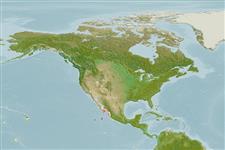Environment: milieu / climate zone / depth range / distribution range
Ökologie
seewasser riff-verbunden; tiefenbereich 6 - 11 m (Ref. 40934). Tropical
Eastern Pacific: Revillagigedo Islands, Mexico.
Size / Gewicht / Alter
Maturity: Lm ? range ? - ? cm
Max length : 19.0 cm SL Männchen/unbestimmt; (Ref. 40934)
Rückenflossenstacheln (insgesamt): 2; Rückenflossenweichstrahlen (insgesamt): 23-26; Afterflossenweichstrahlen: 15 - 17; Wirbelzahl: 24. Body, excluding cheeks, with small, well-defined cream spots on dark background, concentrated in the anterodorsal field; spotting relatively sparse, usually lacking on median fins. Body and head, excluding lips with embedded scales; posterior limb of maxillary scaled. Dorsal spines 2 (rarely 3). Lower jaw only slightly projecting, sometimes with fleshy protuberance. In > 6.5 cm SL specimens, there are numerous, small pores in patches along the ventral surface of lower jaw; those along margin of preopercle confined to patches (Ref. 40934).
Life cycle and mating behavior
Geschlechtsreife | Fortpflanzung | Ablaichen | Eier | Fecundity | Larven
Heemstra, P.C., 1995. Serranidae. Meros, serranos, guasetas, enjambres, baquetas, indios, loros, gallinas, cabrillas, garropas. p. 1565-1613. In W. Fischer, F. Krupp, W. Schneider, C. Sommer, K.E. Carpenter and V. Niem (eds.) Guia FAO para Identification de Especies para lo Fines de la Pesca. Pacifico Centro-Oriental. 3 Vols. FAO, Rome. (Ref. 9342)
IUCN Rote Liste Status (Ref. 130435)
Bedrohung für Menschen
Harmless
Nutzung durch Menschen
Mehr Information
NamenSynonymeMetabolismusRäuberÖkotoxikologieFortpflanzungGeschlechtsreifeAblaichenSpawning aggregationFecundityEierEientwicklung
ReferenzenAquakulturAquakultur ProfilZuchtlinienGenetikElectrophoresesVererbbarkeitKrankheitenVerarbeitungNutrientsMass conversion
PartnerBilderStamps, Coins Misc.LauteCiguateraGeschwindigkeitSchwimmstilKiemenoberflächeOtolithsGehirngrößeSehfähigkeit
Tools
Zusatzinformationen
Download XML
Internet Quellen
Estimates based on models
Preferred temperature (Ref.
123201): 25.1 - 29.1, mean 28 °C (based on 63 cells).
Phylogenetic diversity index (Ref.
82804): PD
50 = 0.5010 [Uniqueness, from 0.5 = low to 2.0 = high].
Bayesian length-weight: a=0.01738 (0.00680 - 0.04443), b=3.01 (2.78 - 3.24), in cm total length, based on LWR estimates for this (Sub)family-body shape (Ref.
93245).
Trophic level (Ref.
69278): 3.9 ±0.7 se; based on size and trophs of closest relatives
Fishing Vulnerability (Ref.
59153): Low vulnerability (13 of 100).
